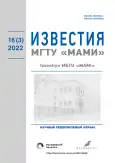Influence of an impeller inlet diameter on operation of a high-speed submersible electric pump at the high flow rate modes
- Authors: Gorbatov D.A.1,2, Zharkovsky A.A.1, Adrianov A.V.3
-
Affiliations:
- Peter the Great St. Petersburg Polytechnic University
- SULAK
- "SULAK"
- Issue: Vol 16, No 3 (2022)
- Pages: 219-224
- Section: Hydraulic and pneumatic systems
- URL: https://journals.rcsi.science/2074-0530/article/view/126628
- DOI: https://doi.org/10.17816/2074-0530-104441
- ID: 126628
Cite item
Full Text
Abstract
BACKGROUND: The study object is a high-speed drainage submersible electric pump, aimed to water polluted sea and fresh water bailing out of drowned rooms of shipbuilding industry facilities.
AIMS: To obtain dependencies of pump cavitation properties on relative diameter of an impeller inlet at the high flow rate modes, to determine the kind of head-capacity and energy properties of a pump for various geometrical ratios of an impeller in the flow rate operational range.
METHODS: Main geometrical properties of impellers were determined with use of semi-empirical formulas of various authors’ methods. For the study of dependencies, three options of impellers were chosen and series of fluid dynamic simulations of three-dimensional flow of viscous fluid with use of the ANSYS CFX software were completed.
RESULTS: Head-capacity, energy and cavitation properties of the pumping unit were obtained. The experimental head-capacity curve correlates to the simulated one. The simulation results revealed that using of narrowed impeller inlet leads to generation of wide low-pressure area at the backside of the impeller vane and disruption of operational curves at the high flow rate modes. With the biggest relative diameter of the impeller inlet, the vapor pressure area at the backside of the impeller is absent so there is no disruption of operational curves at the high flow rate modes, however, the pump hydraulic efficiency ratio at the whole range of flow rate is the lowest among all the studied options of impellers.
CONCLUSIONS: The method of defining the value of an impeller inlet diameter, optimal with regard to energy and cavitation properties, to ensure cavitation free operation of a high-speed submersible electric pump at the whole range of flow rate is proposed.
Full Text
##article.viewOnOriginalSite##About the authors
Daniil A. Gorbatov
Peter the Great St. Petersburg Polytechnic University; SULAK
Email: Da.Gorbatov@yandex.ru
ORCID iD: 0000-0002-3172-3346
SPIN-code: 5727-2661
post graduate
Russian Federation, 29 Politekhnicheskaya street, 195251, Saint Petersburg; Saint PetersburgAlexander A. Zharkovsky
Peter the Great St. Petersburg Polytechnic University
Email: azharkovsky@gmail.com
ORCID iD: 0000-0002-3044-8768
SPIN-code: 3637-7853
Professor, Dr. Sci. (Tech.); Professor
Russian Federation, 29 Politekhnicheskaya street, 195251, Saint PetersburgArtemy V. Adrianov
"SULAK"
Author for correspondence.
Email: mr_a@inbox.ru
ORCID iD: 0000-0003-4853-0804
SPIN-code: 8117-4795
General Director
Russian Federation, 29 Politekhnicheskaya street, 195251, Saint PetersburgReferences
- Zharkovskiy AA, Kurikov NN, Pugachev PV, et al. Computer research and visualization of flow in centrifugal pumps. Nauchno-tekhnicheskie vedomosti SPbGPU. Informatika. Telekommunikatsii. Upravlenie. 2010;4(103):119–123. (in Russ).
- ANSYS CFX Tutorial Guide. Release 17.2. ANSYS Inc.
- Garbaruk AV, Strelets MKh, Travin AK, et al. Sovremennye podkhody k modelirovaniyu turbulentnosti: uch. pos. St. Petersburg.: Izd-vo Politekh. un-ta; 2016. (in Russ).
- Gorgidzhanyan SA. Gidravlicheskie raschety protochnoy chasti tsentrobezhnykh nasosov: metodicheskie ukazaniya po kursovomu proektirovaniyu. Leningrad: LPI im. MI Kalinina; 1982. (in Russ).
- Graueser TE. Abaque pour pompes et pompesturbines reversibl. Lausanne: Institut de machines hydraulignes; 1978.
- Gulich JF. Centrifugal Pumps. Berlin, Heidelberg: Springer-Verlag; 2010.
- Mikhaylov AK, Malyushenko VV. Lopastnye nasosy. Teoriya, raschet i konstruirovanie. Moscow: Mashinostroenie; 1977. (in Russ).
Supplementary files












